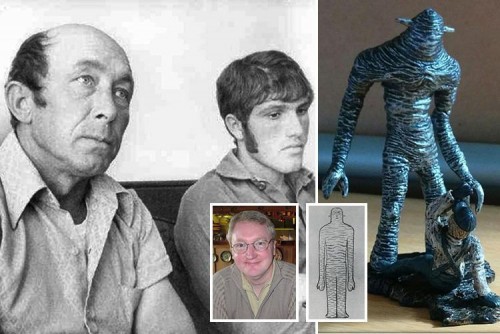The two men found themselves paralyzed and unable to resist being grabbed by the creatures. Parker fainted at this point, and they were then floated up into the spaceship with their abductors. According to Hickson, he was taken into a room full of light and examined by an oval-shaped probe that circled around his body. When the probe had finished its examination, the creatures floated out of the room and then floated Hickson back outside after 20 minutes. Hickson found Parker on the shore, crying and praying. The spaceship then left, and Hickson and Parker went into their car to calm down and try to make sense of what happened.
Although afraid that nobody would believe them, Hickson and Parker called the Kessler Air Force Base, which recommended that they report the incident to the local sheriff. At first, the sheriff and his deputies were skeptical and thought the men were drunk. When they left Hickson and Parker alone in a room with a secret tape recorder, however, they continued to talk as though the experience were real. At one point, Hickson told Parker, “It scared me to death too, son. You can’t get over it in a lifetime. Jesus Christ have mercy.”
The story appeared on local newspaper headlines the next day, and soon news reporters and UFO investigators were crawling all over Pascagoula and harassing Hickson and Parker at their workplace. Hundreds of UFO sightings in Mississippi were reported in the next couple of weeks, including an encounter by some Coast Guardsmen with a glowing object moving underwater in the Pascagoula River.
While Parker initially tried to keep his distance from the incident, Hickson gave media interviews and lectures about his experience, even visiting local schools. In 1983, he published “UFO Contact at Pascagoula” with investigator William Mendez, a full-fledged (and rare) book about the encounter and three incidents of psychic telecommunication he said that he received in 1974. Until he passed away in September 2011, Hickson continued to insist that the story was true and that the creatures he saw were peaceful aliens concerned about the earth.
After participating in some hypnotic sessions, Parker recovered vague memories about what had happened that night. Unlike Hickson, he was wary of the attention he attracted, and eventually moved out of the state. Over the past two decades, he has become more open to interviews and has even participated in UFO conventions.
So what have skeptics had to say about the Pascagoula incident? Hickson’s and Parker’s story made a big splash in national media back in 1973, and some of the biggest names in the UFO investigation community, like J. Allen Hynek and James Harder, believed that the men were telling the truth. While Hickson and Parker did pass lie-detectors, there were inconsistencies in the interviews Hickson gave to the media. Much of the story, in fact, had come from Hickson, since Parker said he passed out. Nobody else in the area, including drivers on a well-used highway, claimed to have seen the UFO.
In an interesting article for the Committee for Skeptical Inquiry, noted paranormal investigator and debunker Joe Nickell suggests that the whole abduction was a vivid hallucination by Hickson. Hickson had drunk some whiskey after the abduction to soothe his nerves, and Nickell suspects that he and Parker might have been drinking before the incident. They fell asleep afterward, but Hickson suffered an episode of hypnagogia, a state of consciousness in which a person is in between sleeping and waking up. Hypnagogic episodes often involve the experiences of paralysis, seeing lights, and feeling as though one is floating. While Parker might not have had a hypnagogic episode himself, he might have been influenced by Hickson and the hypnotic sessions he had undergone
So which was it: a genuine alien abduction or a hoax? Or is that a false dichotomy? In reviewing the case, I thought there might be another possibility: the two men, who might have been drinking before the incident (as Hickson admitted he was after), might have dozed off. Hickson could then have entered a hypnagogic ("waking dream") state, a trancelike condition between waking and sleeping in which some people experience hallucinations, often with bizarre imagery, including strange beings (aliens, ghosts, etc.). This state may be accompanied by what is called "sleep paralysis" (the body`s inability to move due to still being in the sleep mode). In fact, Hickson not only reported the bizarre imagery but also said that the aliens "paralyzed" him before carrying him aboard the UFO in what sounds like a hypnagogic fantasy.
The imagery might even have been triggered by Hickson actually sighting something-almost anything-that, while he was in the waking-dream state, appeared to be a "UFO." During a recorded interview with Sheriff Fred Diamond (Blum with Blum 1974, 30-36), Hickson described the UFO as "a blue light," adding: "It circled a bit." He emphasized it was blue, saying, "And you think you dreamin` about something like that, you know" (original emphasis). Hickson also reported that it made "a little buzzin` sound-nnnnnnnnnn, nnnnnnnnn" (Blum with Blum 1974, 31). Bright lights and odd noises can also be part of the waking-dream experience, as can the sense of floating (Mavromatis 1987, 148). Hickson stated, "I couldn`t resist [the extraterrestrials], I just floated-felt no sensation, no pain" (Blum with Blum 1974, 32). These phenomena, coupled with the paralysis and fantastic imagery, corroborate the diagnosis of a hypnagogic experience.
Of additional corroborative value are other factors, including Hickson`s description of the aliens as speaking inside his head (Clark 1998, 715), because a feature of hypnagogia is the sense of perceiving "with whole consciousness." This explains the bright lights and clarity of his experiences, since hypnagogic visions often seem particularly illuminated, vivid, and detailed (Mavromatis 1987, 14-52, 148).
But if Hickson had a hypnagogic experience, what about Parker? Actually, he need not have been in such a state himself because, as he told officers, he had passed out at the beginning of the incident and failed to regain consciousness until it was over (United Press International 1973). Later he "remembered" bits and pieces of the alleged encounter. This would be consistent with an example of folie a deux (a French expression, the "folly of two") in which a percipient convinces another of some alleged occurrence (as by the power of suggestion, the force of a dominant personality, or the like) or the other person simply acquiesces for whatever reason. (Young Parker`s position was vulnerable: he had recently joined the shipyard where Hickson worked and was residing with the Hicksons.) It would have been significant if Parker had himself been in a hypnagogic state, since "suggestibility is high during this state" (Goldenson 1970, I: 574). Interestingly, when the two men were left alone in a room at the sheriff`s office, where they were secretly tape recorded (Clark 1998, 716), they did not make incriminating statements as they might have if perpetrating a hoax but acted more like people comparing notes to see if they were in agreement with each other.
Still, some of Hickson`s behavior is questionable. For example, he kept adding to his story. He claimed on a television show a month later that the interior lights of the UFO had been so intense as to cause eye injury lasting for three days, although an extensive hospital examination the day after the incident had shown no such eye damage (Klass 1974, 349-50). But this is a familiar story: even accounts of the truest occurrences gain distortions and embellishments over time, so why should Hickson`s story be any different? UFOlogist Kevin D. Randle (2001) insists Hickson`s alterations "went beyond that." Specifically, he says, "These changes seemed to be in response to criticisms and appeared to be an attempt to smooth out rough spots in the story." But to me that just signals Hickson`s defensiveness brought on by people ridiculing him-not proof of initial hoaxing.
When all the facts are weighed, the preponderance of evidence appears not only to favor the hypothesis involving the hypnagogic state but to provide corroboration as well. The realization may not benefit the late Charles Hickson, but it could help others who hear of supposed alien abductions to rest in peace.

On the night of October 11, 1973, co-workers Charles Hickson and Calvin Parker were fishing on the Pascagoula River in Mississippi when the two men suddenly heard a hissing sound coming behind them. When they turned around, they saw an oval-shaped craft hovering in the air and flashing blue lights. A door on the craft opened, and three robot-like creatures floated down toward Hickson’s and Parker’s boat. The creatures were about 5 feet tall, with gray wrinkled skin, clawed hands, and slits for eyes and a mouth.




